Anal hygiene
Anal hygiene, or anal cleansing, refers to hygienic practices that are performed on a person's anus, usually shortly after defecation. The anus and buttocks may be washed or wiped (typically with toilet paper or wet wipes) in order to remove remnants of fecal matter.
In Hindu and Muslim cultures, as well as in Southeast Asia and Southern Europe, water is usually used for anal cleansing—using a jet, as with a bidet, or (most commonly) using the hand. This is sometimes followed by drying the area with a cloth towel or toilet paper. In other cultures—such as many Western countries—cleaning after defecation is generally done with toilet paper only, although some individuals may use water or wet wipes as well, until the person bathes or showers. In some parts of developing countries and during camping trips, materials such as vegetable matter, mud, snow, stones, sticks, and leaves are sometimes used for anal cleansing.[1]
Having hygienic means for anal cleansing available at the toilet or site of defecation is important for overall public health. The absence of proper materials in households can, in some circumstances, be correlated to the number of diarrhea episodes per household.[2] The history of anal hygiene, from ancient Rome and Greece to Japan and China, involves sponges and sticks as well as water and toilet paper.
Toilet paper
.jpg)
The use of toilet paper for post-defecation cleansing first started in China.[3] It became widespread in Western culture.
In some parts of the world, especially before toilet paper was available or affordable, the use of newspaper, telephone directory pages, or other paper products was common. The widely distributed Sears Roebuck catalog was also a popular choice until it began to be printed on glossy paper (at which point some people wrote to the company to complain).[4][5] With flush toilets, using newspaper as toilet paper is liable to cause blockages.
This practice continues today in parts of Africa; while rolls of toilet paper are readily available, they can be fairly expensive, prompting poorer members of the community to use newspapers.
People suffering from hemorrhoids may find it more difficult to keep the anal area clean by only using toilet paper and may prefer washing with water as well.
Although wiping from front to back minimizes the risk of contaminating the urethra, the directionality of wiping varies based on sex, personal preference, and culture.
Some people wipe their anal region standing, others wipe theirs sitting.[6]
Water
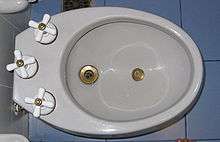
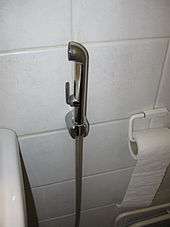
Water with soap cleansing is a reliable and hygienic way of removing fecal remnants.
Muslim societies
The use of water in Muslim countries is due in part to Islamic toilet etiquette which encourages washing after all instances of defecation.[7] There are flexible provisions for when water is scarce: stones or papers can be used for cleansing after defecation instead.
In Turkey, all Western-style toilets have a small nozzle on the centre rear of the toilet rim aiming at the anus. This nozzle is called taharet musluğu and it is controlled by a small tap placed within hand's reach near the toilet. It is used to wash the anus after wiping and drying with toilet paper. Squat toilets in Turkey do not have this kind of nozzle (a small bucket of water from a hand's reach tap or a bidet shower is used instead).
Another alternative resembles a miniature shower and is known as a "health faucet", bidet shower, or "bum gun". It is commonly found to the right of the toilet where it is easy to reach. These are commonly used in the Muslim world. In the Indian subcontinent, a lota vessel is often used to cleanse with water, though the shower or nozzle is common among new toilets.
Indian subcontinent
In India and the Indian subcontinent, over 95% of the population use water for cleansing the anal area after defecating. In places where water is scarce or not closely available, paper or leaves may be used. Use of toilet paper is rare in this region and is seen only in some urban settings. Even when toilet paper is used to clean most of the waste in the anal region, it is followed by water based cleansing. The cleaning of hands with soap after this cleansing process is very important. If soap is not available, soil, ash or sand is used to clean the hands.[8] Toilets may also have spray bidets (health faucets). Simpler toilet rooms may not have running water for anal cleansing and hand washing, but buckets, bails, and mugs are used for storage of water and for the purpose of cleaning.
Southeast Asia
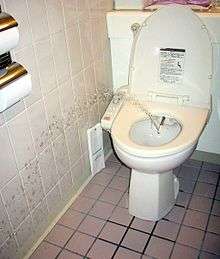
In Southeast Asian countries such as Indonesia, the Philippines, and Thailand, house bathrooms usually have a medium size wide plastic dipper (called gayung in Indonesia, tabo in the Philippines, ขัน (khan) in Thai) or large cup, which is also used in bathing. In Thailand, the "bum gun" is ubiquitous.[9] Some health faucets are metal sets attached to the bowl of the water closet, with the opening pointed at the anus. Toilets in public establishments mainly provide toilet paper for free or dispensed, though the dipper (often a cut up plastic bottle or small jug) is occasionally encountered in some establishments. Owing to its ethnic diversity, restrooms in Malaysia often feature a combination of anal cleansing methods where most public restrooms in cities offer toilet paper as well as a built in bidet or a small hand-held bidet shower connected to the plumbing in the absence of a built-in bidet.
In Vietnam, people often use a bidet shower.[10][9] It is usually available both at general households and public places.
East Asia
The first "paperless" toilet seat was invented in Japan in 1980. A spray toilet seat, commonly known by Toto's trademark Washlet, is typically a combination of seat warmer, bidet and drier, controlled by an electronic panel or remote control next to the toilet seat. A nozzle placed at rear of the toilet bowl aims a water jet to the anus and serves the purpose of cleaning. Many models have a separate "bidet" function aimed towards the front for feminine cleansing. The spray toilet seat is common only in Western-style toilets, and is not incorporated in traditional style squat toilets. Some modern Japanese bidet toilets, especially in hotels and public areas, are labeled with pictograms to avoid language problems, and most newer models have a sensor that will refuse to activate the bidet unless someone is sitting on the toilet.
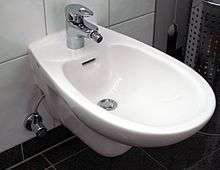
Europe and the Americas
Some people in Europe and the Americas use bidets for anal cleansing with water. Bidets are common bathroom fixtures in many Western and Southern European countries and many South American countries,[12][13][14] while bidet showers are more common in Finland.[15] The availability of bidets varies widely within this group of countries. Furthermore, even where bidets exist, they may have other uses than for anal washing. In Italy, the installation of bidets in every household and hotel became mandatory by law in 1975.
Other
Wipes (wet wipes, gel wipes)
When cleaning babies' buttocks during diaper changes wet wipes are often used, in combination with water if available. As wet wipes are produced from plastic textiles made of polyester or polypropylene, they are notoriously bad for sewage systems as they do not decompose, although the wet wipe industry maintains they are biodegradable but not "flushable".[16][17][18]
A moisturizing gel can be applied to toilet paper for personal hygiene or to reduce skin irritation from diarrhea. This product is called gel wipe.[19] Special foams, sprays and gels can be combined with dry toilet paper as an alternatives to wet wipes.
Cloths
Rags or washcloths are sometimes used. They are then washed similarly to cloth diapers and used again.
Sticks, stones, leaves, corn cobs
In rural areas of developing countries or during camping trips, sticks, stones, leaves, corn cobs and similar are also used for anal cleansing.[20]:162 This can be due to the unavailability of toilet paper or water.
Examples by region or country
- In East Asian, Western and multicultural societies, the Chinese-style use of toilet paper is widespread. Other paper products were also used before the advent of flush toilets.
- Some European and South American countries use a bidet for additional cleaning.
- In South Asia and Southeast Asia, handheld bidets or bidet showers are provided for use in toilets.
- In Ancient Rome, a communal sponge was employed. It was rinsed in a bucket of salt water or vinegar after use.
- In Ancient Greece, fragments of ceramic were sometimes used.
- In Japan, flat sticks were used in ancient times ("shit sticks"), being replaced by toilet paper as the country became more Westernized. Toilets in Japan may include built-in bidets for anal cleansing with warm water.
- In the Indian subcontinent, traditionally cleansing was done by using the left hand and water. Later the hands were washed thoroughly with water and dried, pulverized cow dung (considered antiseptic in Vedic culture) or clay. Today most Indians prefer soap to wash their hands.
History
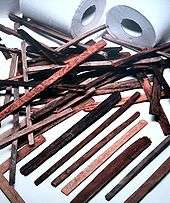
Ancient Greeks were known to use fragments of ceramic known as pessoi to perform anal cleansing.[21]
Roman anal cleansing was done with a sponge on a stick called a tersorium (Greek: xylospongium). The stick would be soaked in a water channel in front of a toilet, and then stuck through the hole in front of the toilet for anal cleaning.[22][23] The tersorium was shared by people using public latrines. To clean the sponge, they washed it in a bucket with water and salt or vinegar. This became a breeding ground for bacteria, causing the spread of disease in the latrine.
In ancient Japan, a wooden skewer known as chuugi was used for cleaning after defecation.
See also
References
- Eds.; Simpson-Hébert, co-authors: Uno Winblad, Mayling (2004). Ecological sanitation (2nd rev and enlarged ed.). Stockholm: Stockholm Environment Institute. p. 67. ISBN 9188714985.
- Herbst, S. (2006). Ecology and development series No. 43, 2006 - Water, sanitation, hygiene and diarrheal diseases in the Aral Sea area. PhD thesis, Göttingen: Cuvillier Verlag
- Needham, Volume 5, Part 1, 123.
- Adams, Cecil (15 August 1986). "What did people use before toilet paper was invented?". The Straight Dope. Retrieved 29 August 2010.
- Rodriguez, Linda (8 July 2009). "Why toilet paper belongs to America". CNN.com. Retrieved 29 August 2010.
- Baragona, Louis (29 August 2018). "Apparently Butt-Wiping Is a Heated Debate". Men's Health. Retrieved 27 July 2019.
- Fataawa al-Lajnah al-Daa’imah: 259 Archived 1 February 2009 at the Wayback Machine. accessed 29 June 2008
- "Complete Guide to Indian Toilets | Learning India". Learning India. 20 January 2014. Retrieved 4 February 2017.
- Nguyen-Okwu, Leslie (9 May 2016). "Trade the Toilet Paper for a Bum Gun". Yahoo News. Retrieved 15 August 2019.
- "Bạn sẽ không nhìn thấy vòi xịt toilet khi đến Mỹ - vì sao vậy?" (in Vietnamese). Retrieved 28 January 2018.
- Roberto Zapperi: Zu viel Moralismus macht den Körper schmutzig., in: FAZ, 24 aprile 2010.
- (in French) L'historique du papier toilette et du bidet
- Decreto ministeriale Sanità, 5 July 1975, art. 7.
- Decreto-Lei n.º 650/75 de 18 de Novembro (in Portuguese), 18 November 1975, art. 84
- "A hose: Always next to every Finnish toilet - Big In Finland". 8 July 2014.
- Pajda, Aleksandra. "Did You Know Wet Wipes Are Made With Plastic? This Is Why the UK Wants Them Banned". One Green Planet. Retrieved 4 January 2019.
- "Wet wipes could face wipe-out in plastic clean-up". BBC News. 8 May 2018. Retrieved 15 August 2019.
- Campbell, Emma (13 November 2018). "No 'flushable' wet wipes tested so far pass water industry tests". BBC News. Retrieved 15 August 2019.
- "Toilet Paper Gel Cleans Up No. 2 In More Ways Than One".
- Tilley, Elizabeth; Ulrich, Lukas; Lüthi, Christoph; Reymond, Philippe; Zurbrügg, Chris. "Septic tanks". Compendium of Sanitation Systems and Technologies (2nd ed.). Duebendorf, Switzerland: Swiss Federal Institute of Aquatic Science and Technology (Eawag). ISBN 978-3-906484-57-0.
- Mirsky, Steve. "Toilet Issue: Anthropologists Uncover All the Ways We've Wiped". Scientific American (2013-03–01).
- Smil, Vaclav (2010). Why America is not a new Rome ([Online-Ausg.] ed.). Cambridge, Massachusetts: MIT Press. pp. 112, 190–191. ISBN 978-0262195935. Retrieved 9 September 2014.
- Shuter, Jane (2004). Life in a Roman fort. Oxford: Heinemann Library. p. 18. ISBN 9780431112985. Retrieved 9 September 2014.